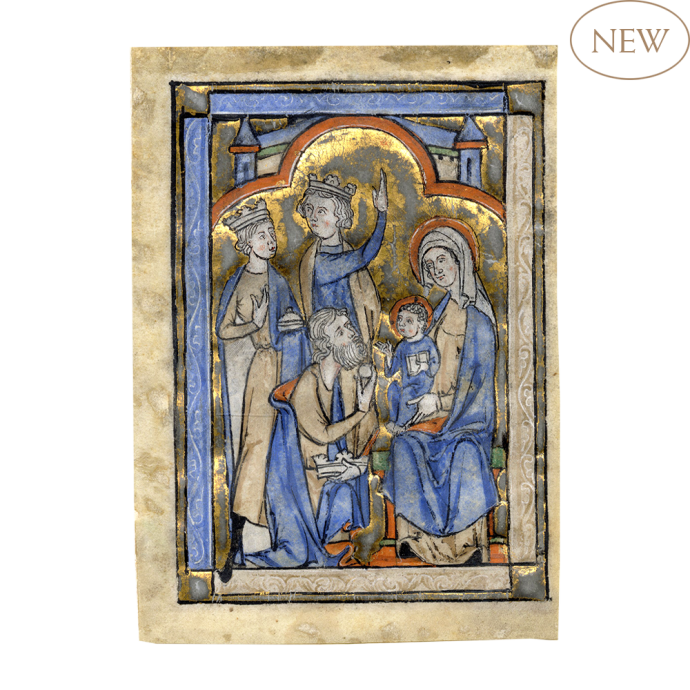


Description
This small, full-page painting is an exquisite witness to manuscript illumination in Paris under the reign of Saint Louis (1226-1270). It depicts the Adoration of the Magi set on a burnished gold ground under a trilobed arch crowned with architectural canopies. The refined palette, the exquisite modeling, as well as the composition and format situate the illumination securely in the Workshop of the Vie de Saint Denis, named by Robert Branner after a Vie de Saint Denis copied in the abbey in 1250 (Paris, BnF, MS n.a.f. 1098). This group of illuminators ranked among the most important in mid-thirteenth century Paris. Our miniature is one of five sister leaves known to come from the prefatory cycle of an illuminated Psalter. The leaves share a distinguished provenance; they were all in the important collection of Robert Forrer at the beginning of the twentieth century.
Hallmarks of the Vie de Saint Denis Workshop are evident in the miniature: the large heads present even facial features, a typical large and rounded jawline, and hair combed in a regular pattern. The composition achieves a subtle balance in varying the gestures and attitudes of the Magi, which respond to one another, and the subtle hues of the palette, which alternates lapis blue and ochre beige. The illuminator demonstrates his mastery in the exquisite shading of the draperies, modelled with darker hues, that succeed in conveying a sense of the figures' elongated bodies, with thin black lines used to render the tension of the garments in the hollow of the armpits, elbows, and knees.
The stylistic peculiarities of the Adoration of the Magi find their best comparisons within the "third group" of manuscripts assembled by Robert Branner in his study of the Vie de Saint Denis Workshop (Branner 1977, pp. 87-93, 225-227). The most compelling example is the illumination of the Ordo ad coronandum regem et reginam francorum achieved around 1250 (Paris, BnF, MS lat. 1246). The first of its two full-page miniatures depicts four moments of the coronation ritual of the French monarchs, set under comparable trefoil arches. Alike the Magi, these groups of figures find their balance in the subtle rhythms of solemn attitudes, rich colors, and spontaneous expressions, characterized by a typical rounded jawline. Consider the subtler modelling achieved in the Adoration of the Magi, it is likely to have been illuminated in the 1250s.
The Adoration of the Magi has been described alongside four full-page miniatures from the same parent manuscript in the catalogue of the Robert Forrer collection in Strasbourg in 1907 and in an auction held subsequently in Leipzig in 1911. These represent the Presentation at the Temple, the Entry into Jerusalem, the Betrayal of Judas, and the Flagellation under the same trefoil arches. At least the first of these is painted by the hand of the Adoration of the Magi. This leaf thus belonged to an extensive cycle of illustrations of the Childhood and Passion of Christ, originally facing each other in pairs, that would have prefixed a small Psalter.
These five miniatures probably contributed to a series of at least ten, succeeding to a calendar, and introducing the Psalms. Such a prefatory cycle of images might have paired the Annunciation with the Visitation, the Nativity with the Adoration of the Magi (present leaf), the Presentation at the Temple with the Flight into Egypt, the Entry into Jerusalem with the Betrayal of Judas, and the Flagellation with the Crucifixion. The blank reverse of the leaf supports this idea, for a blank opening usually separated each pair of prefatory images in such manuscripts. Although the patron of the parent manuscript remains unidentified, it is worth remembering that luxury Psalters like this one were often commissioned by important women of the highest nobility for their private devotion.
Provenance:
1. Robert Forrer (1866-1947), Strasbourg, archeologist, art collector, and museum director: the present leaf and its four sister leaves published and illustrated in the catalogue of his important collection, Unedierte Federzeichnungen Miniaturen u. Initialen des Mittelalters, Strasbourg, 1907, vol. 2, p. 13, pl. XLII.
2. C.G. Boerner, Manuskripte, abendländische Miniaturen, orientalische Miniaturen, Leipzig, 4 December 1911, lot 16, p. 26, with color plate: the present leaf and its four sister leaves sold as one lot, and perhaps inscribed in pencil on the reverse on this occasion.
Sister leaves:
Four sister leaves, of which the current location is unknown, are described and illustrated in the catalogue of the Robert Forrer collection in Strasbourg (1907), and in the Boerner sale in Leipzig (1911):
The Presentation at the Temple;
The Entry of Christ into Jerusalem;
The Betrayal of Judas;
The Flagellation.
Description and Condition:
parchment, with one full-page miniature, reverse blank, inscribed in pencil “Anbetung der Heilige Drei Könige, französ(ische) 13. Jah(under)t,” and “1,” the gold background and frame partly rubbed, the blue pigment abraded, otherwise in good condition. 87 x 65 mm.